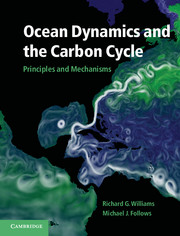Book contents
- Frontmatter
- Contents
- Preface
- Acknowledgements
- Illustration credits
- Part I Introduction
- Part II Fundamentals
- Part III Physical Phenomena and their Biogeochemical Signals
- 7 Seasonality of the upper ocean
- 8 Ocean gyres and intense currents
- 9 Ocean eddies
- 10 Ventilation
- 11 Cycling and transport of nutrients and carbon
- 12 The deep ocean and overturning
- Part IV Synthesis
- Appendix
- Symbols and definitions
- Glossary
- Answers
- References
- Index
- Plate section
8 - Ocean gyres and intense currents
from Part III - Physical Phenomena and their Biogeochemical Signals
Published online by Cambridge University Press: 05 June 2012
- Frontmatter
- Contents
- Preface
- Acknowledgements
- Illustration credits
- Part I Introduction
- Part II Fundamentals
- Part III Physical Phenomena and their Biogeochemical Signals
- 7 Seasonality of the upper ocean
- 8 Ocean gyres and intense currents
- 9 Ocean eddies
- 10 Ventilation
- 11 Cycling and transport of nutrients and carbon
- 12 The deep ocean and overturning
- Part IV Synthesis
- Appendix
- Symbols and definitions
- Glossary
- Answers
- References
- Index
- Plate section
Summary
The atmosphere and ocean share many similar dynamical features. Both fluids move easily over the globe. Together they respond to the latitudinal variation in Sun's heating over the Earth, transferring heat from the tropics to the poles. Over the scale of the planet, this fluid motion is relatively slow, so that winds and currents are strongly affected by the Earth's rotation. The atmosphere and ocean differ, though, in an important and obvious way: the atmosphere easily moves above the Earth's surface, including most of its mountain ranges, whereas the ocean flow is constrained by the land. This difference turns out to be of fundamental importance.
The atmosphere has a strong zonal character to its circulation, particularly at mid latitudes where there are strong upper-air, westerly winds, the Jet Stream. In contrast, the ocean has large-scale recirculations, called gyres, within each of the basins, since zonal flows are blocked by continental barriers. A similar circumpolar flow to the atmosphere only occurs in the Southern Ocean, where the eastward flowing Antarctic Circumpolar Current passes between the gaps in the continents and encircles the globe.
At the simplest level, how ocean gyres rotate can be understood in terms of the twisting force imparted by the surface winds. However, these gyre circulations are surprising in having much stronger flows along their western side than their eastern side. To understand this asymmetrical response, one has to consider how the ocean responds on the basin scale to wind forcing, taking into account that the Earths is a spinning sphere.
- Type
- Chapter
- Information
- Ocean Dynamics and the Carbon CyclePrinciples and Mechanisms, pp. 183 - 210Publisher: Cambridge University PressPrint publication year: 2011



